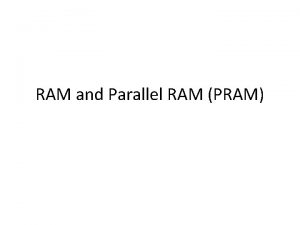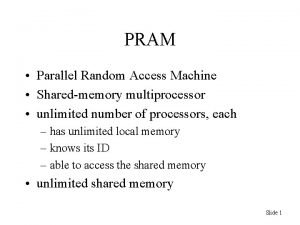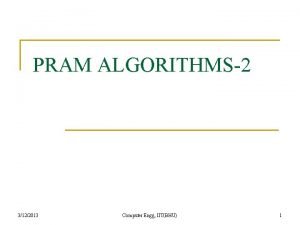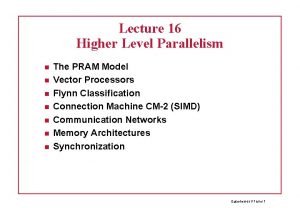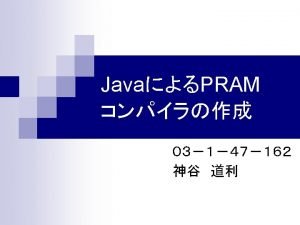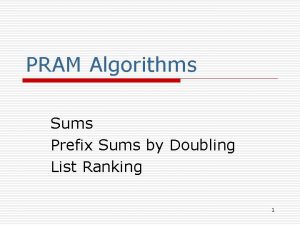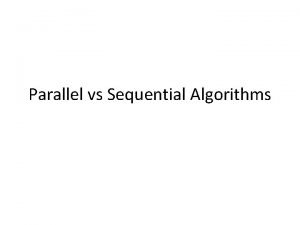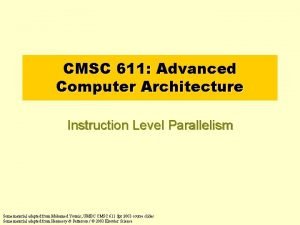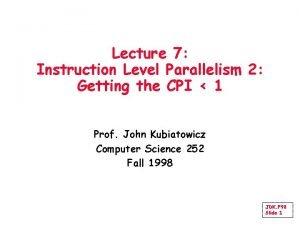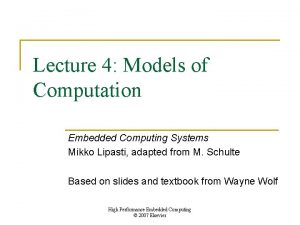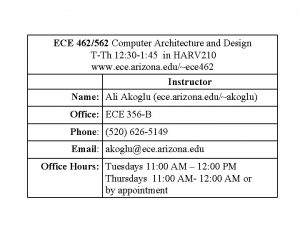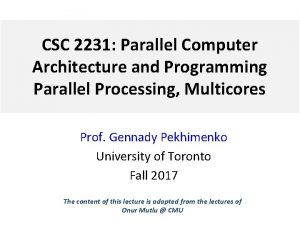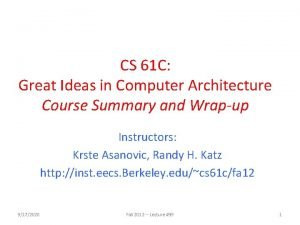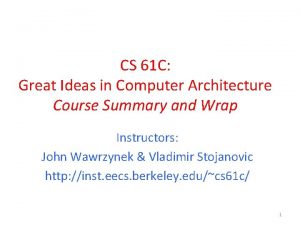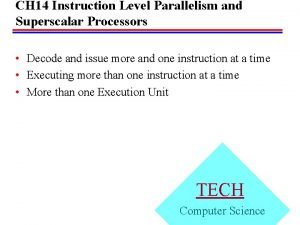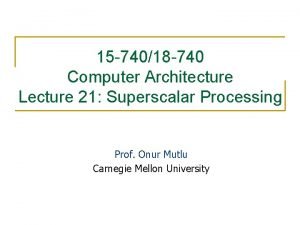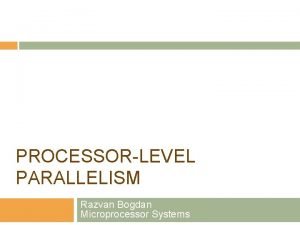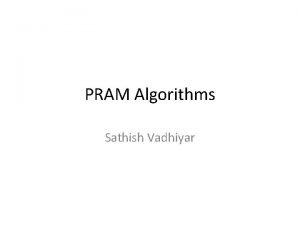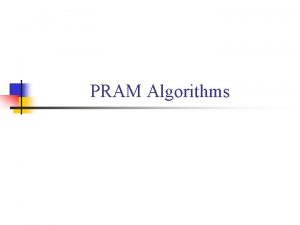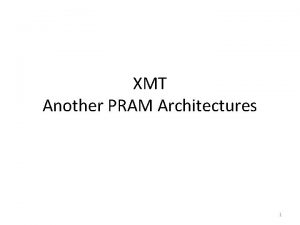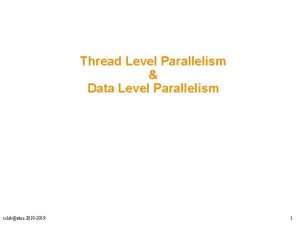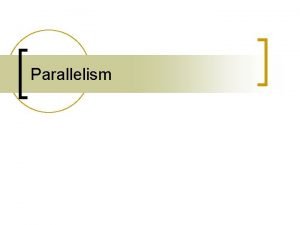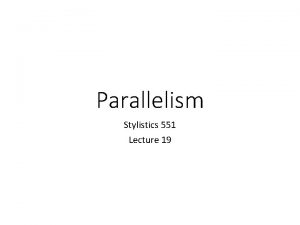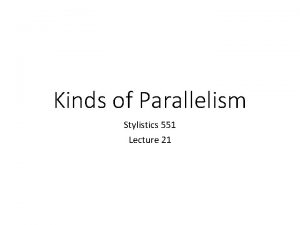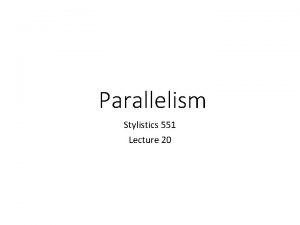Lecture 16 Higher Level Parallelism The PRAM Model



















![SIMD Programming, Parallel sum=0 for (i=0; i<65536; i=i+1) sum=sum+A[Pn, i]; /* Loop over 65 SIMD Programming, Parallel sum=0 for (i=0; i<65536; i=i+1) sum=sum+A[Pn, i]; /* Loop over 65](https://slidetodoc.com/presentation_image_h/2e09c52629f43f52cf5d4651076fce68/image-20.jpg)




- Slides: 24

Lecture 16 Higher Level Parallelism The PRAM Model Vector Processors Flynn Classification Connection Machine CM-2 (SIMD) Communication Networks Memory Architectures Synchronization Datorteknik F 1 bild 1

Amdahl’s Law The performance gain by speeding up some operations is limited by the fraction of the time these (faster) operations are used Speedup = Original T/Improved T Speedup = Improved Performance/Original Performance Datorteknik F 1 bild 2

PRAM MODEL All processors share the same memory space CRCW – concurrent read, concurrent write – resolution function on collision, (first/or/largest/error) CREW – concurrent read, exclusive write EREW – exclusive read, exclusive write Datorteknik F 1 bild 3

PRAM Algorithm Same Program/Algorithm in All Processors Each Processor also have local memory/registers Ex, Search for one value from in an array – Using p processor – Array size m – p=m 3 2 2 5 7 Search for the value 2 in the array 2 5 1 6 Datorteknik F 1 bild 4

Search CRCW p=m 2 A B P 1 P 2 P 3 P 4 P 5 P 6 P 7 P 8 2 2 2 2 3 A B 2 5 7 2 5 1 6 step 1: concurrent read A the same memory is accessed by all processors step 2: read B different memory addresses for each processor P 1 P 2 P 3 P 4 P 5 P 6 P 7 P 8 2 2 2 2 3 2 5 7 2 5 1 6 Datorteknik F 1 bild 5

Search CRCW p=m A B P 1 P 2 P 3 P 4 P 5 P 6 P 7 P 8 2 2 2 2 3 2 5 7 2 5 1 6 1 step 3: concurrent write 1 if A=B else 0 We use “or” resolution 1: Value found 0: Value not found Complexity • All operations performed in constant time • Count only the cost of communication steps • In this case the number of steps is independent of m, (if enough processors) • Search is done in constant time O(1) for CRCW and p=m Datorteknik F 1 bild 6

Search CREW p=m P 1 P 2 P 3 P 4 P 5 P 6 P 7 P 8 2 2 2 2 3 2 5 7 2 5 1 6 0 1 0 0 0 log 2 m steps P 1 0 1 1 P 2 0 0 0 P 3 0 1 1 P 4 0 0 0 P 2 P 1 step 3: compute 1 if A=B else 0 Same processors can be reused in the next step! step 4. 1: read A step 4. 2: read B step 4. 3: compute A or B Complexity • We need log 2 m steps to “collect” the result • Operations done in constant time • O(log 2 m) complexity Datorteknik F 1 bild 7

Search EREW p=m 2 P 1 log 2 m P 1 P 2 steps P 1 P 2 P 3 P 4 P 5 P 6 P 7 P 8 It takes log 2 m steps to distribute the value, more complex? NO, the algorithm is still in O( log 2 m) only the constant differs Datorteknik F 1 bild 8

PRAM a Theoretical Model CRCW – Very elegant – Not of much practical use, (too hard to implement) CREW – This model can be used to develop algorithms for parallel computers, e. g. our search example p=1 (a single processor), check all elements give O(m) 2 p=m (m processors), complexity O(log m), not O(1) – From our example we conclude that even in theory we do not get a m-times “speedup” using m-processors THAT IS ONE BIG PROBLEM WITH PARALLEL COMPUTERS Datorteknik F 1 bild 9

Parallelism so far By pipelineing several instructions (at different stages) are executed simultaneously – Pipeline depth limited by hazards Super. Scalar designs provide parallel execution units – Limited by instruction and machine level parallelism – VLIW might improve over hardware instruction issuing All limited by the instruction fetch mechanism – Called the FLYNN BOTTLENECK – Only a very limited nr of instructions can be fetched each cycle – That makes vector operations ineffective Datorteknik F 1 bild 10

Vector Processors Taking Pipelineing to its limits for vector operations – Sometimes referred as a Super. Pipeline The same operation is performed on a vector of data – No data dependencies in the vector data – Ex, add two vectors Solves the FLYNN BOTTLENECK problem – A loop over a vector can be issued by a singe instruction Proven to be very effective for scientific calculations – CRAY-1, CRAY-2, CRAY-XMP, CRAY-YMP Datorteknik F 1 bild 11

Vector Processor (CRAY-1 like) MAIN MEMORY FP add/subtract FP multiply Vector load/store Vector registers FP divide Integer Logical Super. Pipelined Arithmetical units Scalar registers (like MIPS reg file) Datorteknik F 1 bild 12

Vector Operations Fully Pipelined – CPI = 1, we produce one result each cycle when pipe full Pipeline Latency – Startup cost = pipeline depth Vector Add 6 cycles Vector Multiplication 6 cycles Vector Divide 20 cycles Vector Load 12 cycles (depends on memory hierarchy) Sustained rate – Time/element for a collection of related vector operations Datorteknik F 1 bild 13

Vector Processor Design Vector length control – VLR register (Maximum Vector Length, MVL) – Strip Mining in software (Vector > MVL causes a loop) Stride – How to layout a vectors and matrixes in memory, such that – Memory banks can be accessed without collision Vector Chaining – Forwarding between vector registers (minimize latency) Vector Mask Register (Boolean valued) – Conditional writeback, (if 0 no writeback) – Sparse matrixes and conditional execution Datorteknik F 1 bild 14

Programming By use of language constructs the compiler is able to utilize the vector functions FORTRAN is widely used for scientific calculations – built in matrix and vector functions/commands LINPACK – A library of optimized linear algebra functions – Often used as a benchmark (but does it tell the whole truth? ) Some more (implicite) vectorization possible by advanced compilers Datorteknik F 1 bild 15

Flynn Classification SISD (Single Instruction, Single Data) – The MIPS, and even the Vector Processor SIMD (Single Instruction, Multiple Data) – Each instruction activates several execution units in parallel MISD (Multiple Instruction, Single Data) – The VLIW architecture might be considered but…. MISD is a seldom used classification MIMD (Multiple Instruction, Multiple Data) – Multiprocessor architectures – Multi computers (communicating over a LAN), sometimes treated as a separate class of architectures Datorteknik F 1 bild 16

Communication Bus • Total Bandwidth = Link Bandwidth • Bisection Bandwidth = Link Bandwidth Ring • Total Bandwidth = P * Link Bandwidth • Bisection Bandwidth = 2 * Link Bandwidth Fully Connected • Total Bandwidth = (P * P-1)/2 * Link Bandwidth 2 • Bisection Bandwidth = (P/2) * Link Bandwidth Datorteknik F 1 bild 17

Multi. Stage Networks Crossbar Switch P 1 to P 2, P 3 P 2 to P 4 P 3 to P 1 P 2 P 3 P 4 Omega Network P 1 to P 6, but P 2 to P 8 not possible at the same time log 2 P P 1 P 2 P 3 P 4 P 5 P 6 P 7 P 8 Datorteknik F 1 bild 18

Connection Machines CM-2 (SIMD) 16 1 -bit Fully Connected CPUs on each Chip Each CPU has 3 1 -bit registers and 64 k-bit memory 3 -cube 1024 * Chips 512 FPAs Front end SISD 16 k 1 -bit CPUs 512 FPAs Sequencer 16 k 1 -bit CPUs 512 FPAs CM-2 uses a 12 -cube for communication between the chips Data Vault (Disk Array) Datorteknik F 1 bild 19
![SIMD Programming Parallel sum0 for i0 i65536 ii1 sumsumAPn i Loop over 65 SIMD Programming, Parallel sum=0 for (i=0; i<65536; i=i+1) sum=sum+A[Pn, i]; /* Loop over 65](https://slidetodoc.com/presentation_image_h/2e09c52629f43f52cf5d4651076fce68/image-20.jpg)
SIMD Programming, Parallel sum=0 for (i=0; i<65536; i=i+1) sum=sum+A[Pn, i]; /* Loop over 65 k elements */ /* Pn is the processor number */ limit=8192; half=limit; /* Collect sum from 8192 processors */ repeat half=half/2 /* Split into sender/receiver */ if (Pn>=half && Pn<limit) send(Pn/2 -half, sum); if (Pn<half) sum=sum+receive(); limit=half; until (half==1) /* final sum */ limit 4 3 half 2 1 0 send(1, sum) send(0, sum) sum=sum+R limit 2 half 1 send(0, sum) 0 sum=sum+R 0 Final sum Datorteknik F 1 bild 20

SIMD vs MIMD SIMD – Single Instruction (one PC) – All processors perform the same work (synchronized) – Conditional execution (case/if etc) Each processor holds a enable bit MIMD – Each processor has a PC Possible to run different programs: BUT – All may run the same program (SPMD), single Program. . . Use MIMD style programming for conditional execution Use SIMD style programming for synchronized actions Datorteknik F 1 bild 21

Memory Architectures for MIMD – Centralized We use a single bus for all main memory Uniform memory access, (after passing the local cache) – Distributed The sought address might be hosted by another processor Non-uniform memory access, (dynamic “find” time) The Extreme, a cache only Memory – Shared All processors shared the same address space Memory can be used for communication – Private All processors have a unique address space Communication must be done by “message passing” Datorteknik F 1 bild 22

Shared Bus MIMD Processor Usually 2 -32 P Processor … Snoop Tag Cache Coherency Protocol MEMORY Cache I/O • Write Invalidate The first write to address A causes all other cached references of A to be invalidated • Write Update On write to address A all cached references of A is updated (high bus activity) • On a cache read miss when using WB caches • The cache holding the valid data writes to memory • The cache holding the valid data writes directly to the cache requiring the data Datorteknik F 1 bild 23

Synchronization When using shared data we need to se that only one processor can access the data when updating We need an atomic operation. Processor for TEST&SET 2 Processor 1 loop: TEST&SET A. lock beq A. go loop update A clear A. lock Processor 1 gets the lock (A. go) updates the shared data and finally clears the lock (A. lock) Processor B spin-waits until lock released updates shaded data and releases lock Datorteknik F 1 bild 24
 Thread-level parallelism
Thread-level parallelism Pram ram
Pram ram Pram model of negotiation
Pram model of negotiation Pram model
Pram model Crew pram
Crew pram Pram
Pram Pipelineing
Pipelineing Pram and vlsi models
Pram and vlsi models Nistir 8062
Nistir 8062 Score pram asthme
Score pram asthme Pram
Pram Packed prefix
Packed prefix Parallel vs sequential algorithms
Parallel vs sequential algorithms Pram
Pram 01:640:244 lecture notes - lecture 15: plat, idah, farad
01:640:244 lecture notes - lecture 15: plat, idah, farad Instruction level parallelism in computer architecture
Instruction level parallelism in computer architecture Instruction level parallelism
Instruction level parallelism Task level parallelism
Task level parallelism Ece 369
Ece 369 Computer architecture
Computer architecture 8 great ideas in computer architecture
8 great ideas in computer architecture Task level parallelism
Task level parallelism In order issue in order completion example
In order issue in order completion example Task level parallelism
Task level parallelism Bit level parallelism
Bit level parallelism

